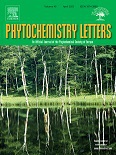New C9-polyacetylenes from the essential oil of the highly endangered species Baccharis palustris Heering (Asteraceae)
Dublin Core
Título
Tema
Abstract
The essential oil composition of the aerial parts from Baccharis palustris Heering (Asteraceae), a highly endangered species, was analyzed by GC/qMS, GC/HRMS-TOF, FT-IR, UV–vis and NMR spectroscopy using 1D and 2D techniques. To our knowledge, this is the first report on the essential oil composition of B. palustris, as well as the first phytochemical study on this plant species. The volatile extracts were obtained from different phenologicals stages of plant, at flowering stage (FS) and vegetative stage (VS), where 51 components were identified accounting for 96.3 % and 99.0 % of the oil, respectively. The oil was rich in polyacetylene compounds (> 75 %), being the main components identified the new natural C9-polyacetylenes 1-nonene-3,5-diyne (1, here named as
baccharisdiyne) (52.7–65.0 %), 1,7(Z)-nonadiene-3,5-diyne [2, 7(Z)-dehydro-baccharisdiyne] (14.4–17.8 %), and 1,7(E)-nonadiene-3,5-diyne [3, 7(E)-dehydro-baccharisdiyne] (1.5–2.4 %). In addition, the known polyacetylenic compounds (Z)-lachnophyllum acid methyl ester (4) (4.3–5.3 %) and (E)-lachnophyllum acid methyl ester (5) (0.2 %) were also identified. Moreover, GC/qMS analysis allowed the identification of other 46 components in the essential oil samples, mainly mono- and sesquiterpenoids. In B. palustris, C9-polyacetylenes
probably derive biogenetically from a C10 precursor: baccharisdiyne (1) would be derived from either or both
lachnophyllum methyl ester geometric isomers (4 or 5), by enzymatic hydrolysis followed by decarboxylation. Dehydro-baccharisdiynes (2 and 3) could be produced by a similar pathway starting from the corresponding matricaria acid methyl ester isomers, one of which was tentatively identified at trace-level in B. palustris essential oil.
Autor
Fuente
Editor
Fecha
Derechos
Información sobre Derechos de Autor
(Por favor lea este aviso antes de abrir los documentos u objetos)
La legislación uruguaya protege el derecho de autor sobre toda creación literaria, científica o artística, tanto en lo que tiene que ver con sus derechos morales, como en lo referente a los derechos patrimoniales con sujeción a lo establecido por el derecho común y las siguientes leyes (LEY 9.739 DE 17 DE DICIEMBRE DE 1937 SOBRE PROPIEDAD LITERARIA Y ARTISTICA CON LAS MODIFICACIONES INTRODUCIDAS POR LA LEY DE DERECHO DE AUTOR Y DERECHOS CONEXOS No. 17.616 DE 10 DE ENERO DE 2003, LEY 17.805 DE 26 DE AGOSTO DE 2004, LEY 18.046 DE 24 DE OCTUBRE DE 2006 LEY 18.046 DE 24 DE OCTUBRE DE 2006)
ADVERTENCIA: La consulta de este documento queda condicionada a la aceptación de las siguientes condiciones de uso: Este documento es únicamente para usos privados enmarcados en actividades de investigación y docencia. No se autoriza su reproducción con fines de lucro. Esta reserva de derechos afecta tanto los datos del documento como a sus contenidos. En la utilización o cita de partes debe indicarse el nombre de la persona autora.Formato
Idioma
Tipo
Identificador
Document Item Type Metadata
Original Format
- Fecha de agregación
- May 19, 2022
- Colección
- Bibliografía Nacional Química
- Tipo de Elemento
- Document
- Etiquetas
- Aceites esenciales, Asteráceas, Baccharis palustris, Biogénesis, Poliacetilenos
- Citación
- Minteguiaga, Manuel, “New C9-polyacetylenes from the essential oil of the highly endangered species Baccharis palustris Heering (Asteraceae),” RIQUIM - Repositorio Institucional de la Facultad de Química - UdelaR, accessed August 25, 2024, https://riquim.fq.edu.uy/items/show/6501.
- Archivos

